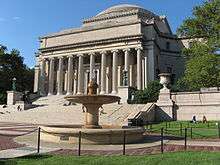Core Curriculum (Columbia College)
The Core Curriculum was originally developed as the main curriculum used by Columbia University's Columbia College in 1919. Today, customized versions of the Core Curriculum are also completed by students in the School of Engineering and Applied Science and the School of General Studies (the other two undergraduate colleges of Columbia University).
The curriculum began in 1919 with "Contemporary Civilization", about the origins of western civilization. It became the framework for many similar educational models throughout the United States.[1] Later in its history, especially in the 1990s, it became a heavily contested form of learning, seen by some as an appropriate foundation of a liberal arts education, and by others as a tool of promoting a Eurocentric or Anglocentric society by solely focusing on the works of "dead white men".[2] In response, the College added requirements for courses in "major cultures" during the 1980s.[3] Recent controversy over the "Core" has been related to whether visiting artists to Columbia should have their works added to the syllabus, as was the case with a play by Václav Havel in Fall 2006. A major addition to the core was made in the 2000s, when a science literacy course, "Frontiers of Science", was added.[4]
History

Original intentions
US universities, including Harvard, had seen a trend towards more elective programs during the late 19th century.[5] Columbia's president Frederick Augustus Porter Barnard supported this trend, but his stance lost ground at the College over the following decades.[5] Previously, a liberal arts education rarely focused directly on a major, but would focus on both Greek and Latin classics. The changes were first initiated in the 1880s with the inclusion of courses in study of a modern language. This change, along with a latter change in campus location preceding World War I set the stage for a major change in curricula focus after the war. The "Contemporary Civilization" course of the time has also been described as a direct response to the US entry into the war, seeking to encourage US involvement by stressing the importance of Western civilization.[6] Its persistence has been attributed to the College's wish to retain authority and autonomy with regard to the university's more specialized graduate programs.[7]
Changes to the Core
In the later half of the 20th century US universities moved towards a more elective system. Some historians see the change as a response to social activism[1] - the civil rights, feminist, and various other social movements saw the core curriculum as an inflexible way to promote the canon of "dead white males" and as a failure to acknowledge the essential contributions of other global cultures. Others interpret it as a concession to increasing calls for earlier specialization to prepare students for post-graduate scientific and professional studies.[1]
The Core Curriculum at Columbia has been extended to consider "Major Cultures" as well as greater depth of study in art and music. While Columbia has maintained its Core Curriculum, other undergraduate institutions have either abandoned or modified similar approaches, turning from a prescribed set of courses to "distribution" requirements that aim to ensure educational breadth. The latter are sometimes described as a "core curriculum"; Harvard's review of its requirements illustrates this approach.[8]
The most recent addition to the Core (2004) is Frontiers of Science, which includes a set of analytical approaches that apply to all disciplines of science. Frontiers is taught as four, 3 week units: two from the physical sciences (for example, Astronomy and Geology) and two from the life sciences (for example, Neuroscience and Biodiversity).
Structure
Requirements
The Core Curriculum is an example of what was adopted by many educational institutions in the years following its introduction. All first-year students in the college must take the year-long "Masterpieces of Western Literature" course (known as "Literature Humanities" or Lit Hum), the semester-long "University Writing", and the semester-long "Frontiers of Science". All sophomores are required to take a year of "Contemporary Civilization" (known as CC). The other requirements, which can be completed any year, include a semester of "Music Humanities"; a semester of "Art Humanities"; two semesters of science, four semesters of a foreign language, two semester-long courses about non-Western major cultures, and two semesters of physical education. Students are also required to pass a swimming test before receiving their diplomas, a common feature among Ivy League colleges.
References
- Thomas J. Lasley, II; Thomas C. Hunt; C. Daniel Raisch (2010). Encyclopedia of Educational Reform and Dissent. SAGE Publications. p. 401. ISBN 978-1-4129-5664-2.
- William Theodore De Bary (2007). Confucian tradition and global education. Columbia University Press. p. 28. ISBN 978-0-231-14120-8.
- David Denby (1997). Great books: my adventures with Homer, Rousseau, Woolf, and other indestructible writers of the Western world. Simon & Schuster. p. 62. ISBN 978-0-684-83533-4.
- Frédéric Darbellay; Moira Cockell; Jerome Billotte (2008). A Vision of Transdisciplinarity: Laying Foundations for a World Knowledge Dialogue. CRC Press. pp. 152, 153. ISBN 978-1-4200-9228-8.
- Robert A. McCaughey (2003). Stand, Columbia : a history of Columbia University in the city of New York, 1754-2004. Columbia University Press. p. 287. ISBN 978-0-231-13008-0.
- Henry James; Pierre A. Walker (1999). Henry James on culture: collected essays on politics and the American social scene. University of Nebraska Press. p. xxii. ISBN 978-0-8032-2589-3.
Columbia college core world war james.
- Rosalind Rosenberg (2004). Changing the subject: how the women of Columbia shaped the way we think. Columbia University Press. p. 273. ISBN 978-0-231-12644-1.
- "Archived copy". Archived from the original on 2007-08-09. Retrieved 2009-08-17.CS1 maint: archived copy as title (link) curriculum review
